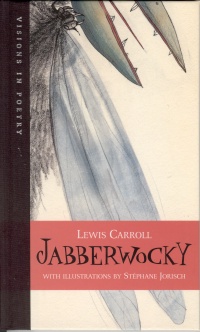| ________________
CM . . .
. Volume XI Number 2 . . . . September 17, 2004
excerpt:
The poem "Jabberwocky" was first published in Lewis Carroll's Through the Looking Glass which appeared in 1872. In the original text, this poem was written backwards, and Alice came up with the idea of decoding it by holding it up to the "looking-glass." In the story, Humpty Dumpty explains to her that the poem "Jabberwocky" is made up of portmanteaus or invented words. For example, slithy is an amalgamation of lithe and slimy. Jorisch's interpretation of the poem is the first book in a projected series titled "Visions in Poetry" that will feature classic poems illustrated by contemporary illustrators. The title and series name is handsomely gold stamped on the black book cloth wrapping the spine, and a part of the Jabberwock's menacing snout appears at the top of the cover. The book designer has chosen an unusual font for the title - called Daddy O Hip - and right away we know that this is a book with a difference! Inside, the portmanteaus or word collages are displayed in a different font from the regular words in this lyrical and rhythmical adventure in wordplay and altered meaning. The full colour illustrations are rendered in pencil, ink, watercolour and Adobe Photoshop. Jorisch's viewpoint is quite different from that of other illustrators like Graeme Base who painted a medieval backdrop for his Jabberwocky (Abrams, 1987) or Jane Breskin Zalben's version titled Lewis Carroll's Jabberwocky (Warne, 1977). Her soft delicate and playful watercolours stand in sharp contrast to Jorisch's mature and sophisticated interpretation of the text. For him, the text conjures up a multiplicity of meanings, and, in response, he has created a story tableau with repeating motifs which are a running commentary on modern politics, media, gender and war. His 'looking-glass" on today's world is menacing and Orwellian with images of a helmeted soldier on televisions, naked mannequins pierced by a sewing needle, and violence, especially in the blood splattered slaying of the jabberwock by a "soldier" in make-up and dressed in hockey shoulder pads. Some of his illustrations are reminiscent of Charles Keeping's work in their linear fluidity and the frontal placement of figures and faces. But Jorisch is completely original in this compelling interpretation right up to the surprising "epilog" illustration in which children are slaying a drawing of the jabberwock on the pavement. Lewis Carroll's strange word juxtapositions are perfectly matched by Jorisch's visual surrealism. Teachers could use this book to spark discussion on its themes and also for creative writing. Most of Lewis Carroll's work has been of great interest to artists, and this book would be of interest to contemporary artists and book designers for its unique vision and handsome presentation. It would also interest middle school and senior high students who will find the illustrations and text full of puzzling questions. Highly Recommended. Lorraine Douglas is a Winnipeg, MB, artist and writer.
To comment
on this title or this review, send mail to cm@umanitoba.ca.
Copyright © the Manitoba Library Association. Reproduction for personal
use is permitted only if this copyright notice is maintained. Any
other reproduction is prohibited without permission.
NEXT REVIEW |TABLE OF CONTENTS FOR THIS ISSUE
- September 17, 2004.
AUTHORS
| TITLES | MEDIA REVIEWS
| PROFILES
| BACK ISSUES
| SEARCH | CMARCHIVE
| HOME |
